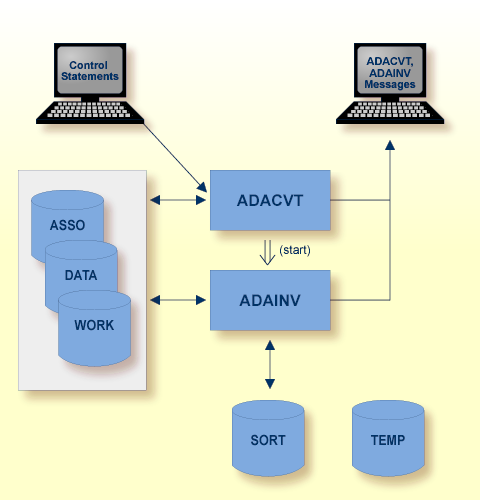This document describes the utility "ADACVT".
The following topics are covered:
The utility ADACVT converts an existing database in place. The conversions performed are described below.
ADACVT enables the conversion of a database in both directions:
From a previous version to the current version and;
From the current version to a previous version.
When converting a database
The nucleus must not be active or;
The nucleus must not have an AUTORESTART pending;
The nucleus must not have utility entries in the utility control block (UCB).
Prior to converting a database, it is highly recommended that you:
Use ADABCK to dump the database;
Use ADAVFY'S FIELD and INDEX functions to verify the consistency of the database.
Note
The verification of the database can be done either before or
after dumping the database.
The new Adabas version works best if the database is registered in the ADABAS.INI file. If the database is not registered, but a corresponding DBxxx.INI file is available, then ADACVT adds the database into the ADABAS.INI file.
During the conversion, the new structure level and the AUTOSTART option are adapted in ADABAS.INI.
Notes:
This utility is a single-function utility. For more information about single- and multi-function utilities, see Adabas Basics -> Using Utilities -> Single- and Multi-function utility.

| Data Set | Environment Variable/ Logical Name |
Storage Medium |
Additional Information |
|---|---|---|---|
| Associator | ASSOx | Disk | |
| Data storage | DATAx | Disk | |
| Sort storage | SORTx TEMPLOCx |
Disk | Administration Manual, temporary working space |
| Control statements | stdin/ SYS$INPUT |
||
| ADAINV messages | stdout/ SYS$OUTPUT |
Messages and Codes | |
| Temporary storage | TEMPx | Disk |
On successful completion, ADACVT writes a SYNP checkpoint.
The following control parameters are available:
M DBID = number
M CONVERT = {target version}
DBID = number
This parameter selects the database to be converted.
CONVERT = {target version}
This parameter specifies the structure of the destination version. It can take values of the format V<major version number><minor version number>0. For example:
- V670
Converts a database from version nn0 to Version 6.7.
or
- Vnn0
Converts a database to version nn0.
Note
In the above description nn is the
current version of Adabas; the 1st digit denotes the major version, the 2nd
digit the minor version.
ADACVT DBID=number CONVERT=V700
An attempt is made to convert the database with the DBID = number to Version 7.0.
If ADACVT is unable to restart after a crash, restore the original database from the backup and run the utility again.